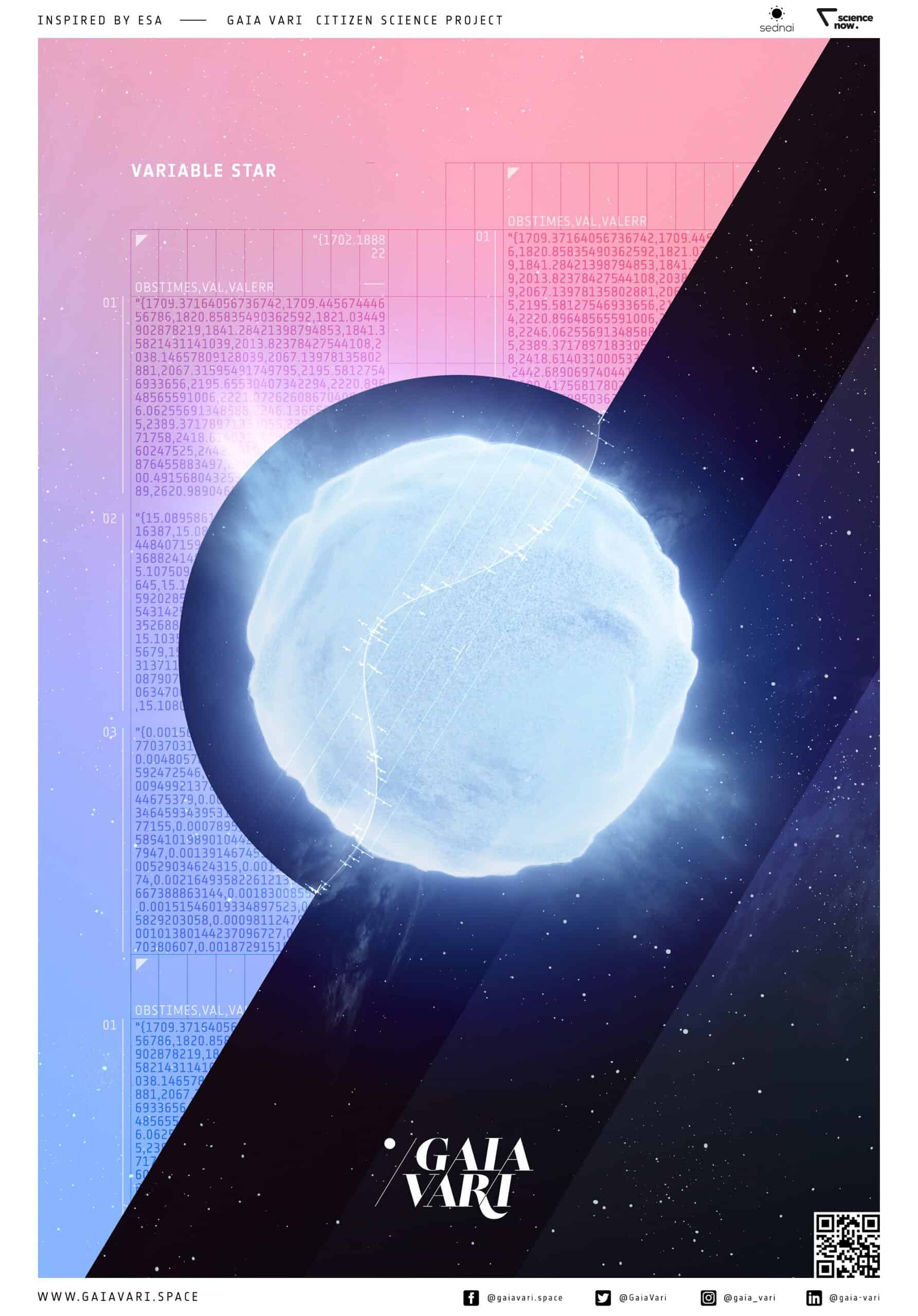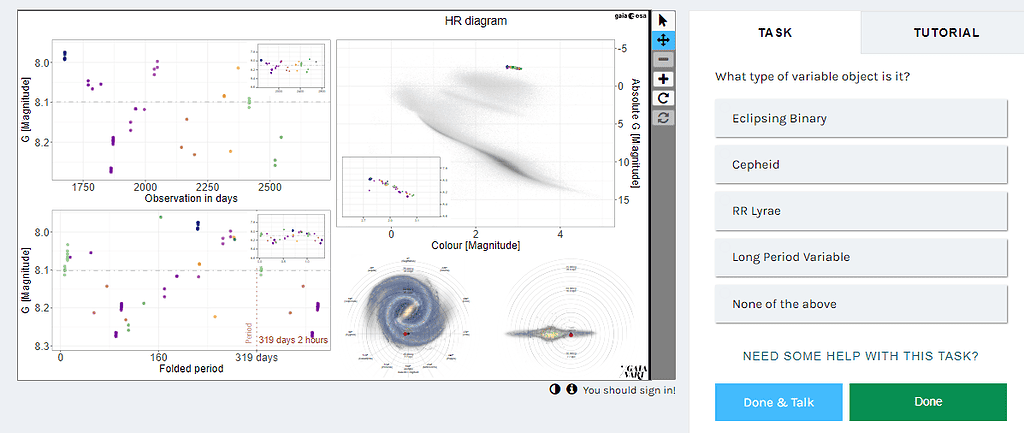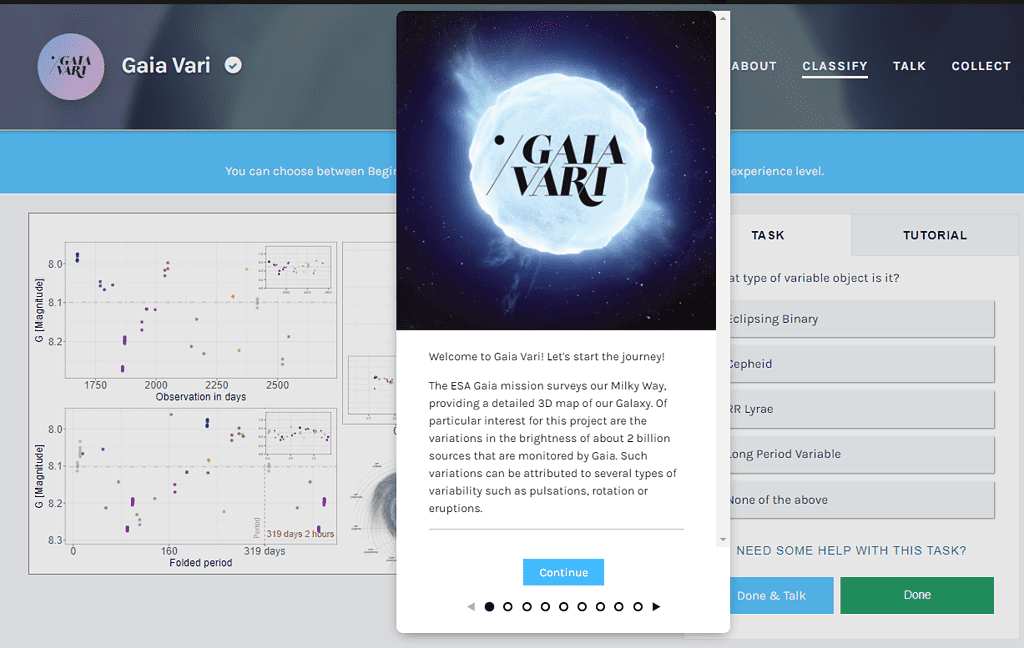“There’s one person, for example, who is really good at classifying. I don’t know his name, but I think he’s better than I am and better than some of my colleagues,” says Laurent Eyer head of ESA Gaia Coordination Unit 7.
Eyer is referring to one of the citizen scientists involved in the Gaia Vari project, where amateurs can classify variable stars — stars that change in brightness over time. These observations are helping astronomers better understand these celestial bodies and they’re paving the way for exciting and new discoveries.
The best part about it? It only takes 10 minutes to get started.

How to become a citizen astronomer
We met up with Eyer and Milena Ratajczak, an astronomer at the University of Warsaw with an interest in variable stars, at the European Astronomical Society’s meeting (EAS 2023). The two are core members of the Gaia Vari project, where over 850 volunteers have signed up to classify some 10,000 cosmic sources. All in all, amateur astronomers have produced over 200,000 classifications — and this is just the first part of the project.
“I think this campaign is bringing information which can result in several scientific publications in journals,” Eyer says.
The project revolves around the Gaia Observatory. Gaia, which was launched by the European Space Agency (ESA), is building by far the largest and most precise 3D space catalog ever made. This catalog totals approximately one billion astronomical objects, mainly stars, but also planets, comets, asteroids, and quasars, among others.
This brings up a pretty good problem to have: there’s a huge amount of data to analyze. Although Gaia’s telescopes are incredibly powerful, astronomers can still use some good old-fashioned tools: your eyes.
“Gaia has allowed us to perform a systematic study of what is visible in the universe. To look at this data, you have the automated machine learning techniques that are very mathematical and you have the specialist scientists doing their work. So we had the idea of also doing a citizen science project where you go through the data star by star,” Eyer explains. It’s like having a third way of looking at the data.
What do citizen scientists actually do in this project
“They don’t look at images, that’s the first thing,” says Ratajczak. “Very often, citizen science projects in astronomy are associated with colorful images, but this is not the case here.”

Instead, you look at data points about stars (or other sources). This information refers to things like brightness or color. Thanks to Gaia, there are often multiple data points for the same source, so you can track how the brightness and the color change in time, the astronomer adds.
“With some additional information about the period, how often it changes and where’s the source located in the galaxy (because this is also something that we know from Gaia), we can extract information about what kind of objects we are looking at.”
Within Gaia Vari, you can help classify Gaia’s variable stars — stars that change in brightness over time. These observations are then mixed with other data to better understand these celestial bodies.
The approach is also used to finesse existing algorithms. Sometimes, things are “boring,” as Eyer puts it — the algorithm and the scientists, and the citizen scientists are all in agreement about how to classify one object. But sometimes, these classifications are different. That usually happens when citizen scientists did better than the algorithm and experts have to step in to review the situation.
“When multiple people tag the same information, that’s when we know we have to take a look,” says Ratajczak. “Otherwise, we can’t look at every single object in the database, it’s just too big.” Overall, there were over 90,000 comments from the citizen scientists.
The whole process is also very straightforward. There’s a tutorial you follow and then, in only a few minutes, you can start classifying. You can also comment and interact with the rest of the community.
Researchers say that sometimes, it’s clear that some of the users didn’t really go through the tutorial. But even in these cases, they see users progress and do a better and better job as time goes on.
“It’s learning by doing,” Eyer mentions. “You see that people are improving. I think this is really a success”

What findings did citizen scientists make in Gaia Vari?
Apart from helping with the classification, amateur astronomers are even making valuable findings. It’s pretty incredible, but some of these findings made by amateurs can help us better understand the universe.
“We are finding interesting objects. You have, for example, the R Coronae Borealis stars that shoot in the interstellar medium so they enrich the interstellar medium,” explains Eyer. “There are scientists who are studying them in detail, and thanks to Gaia Vari, we found a few good candidates.”
“Will these be confirmed? I think some will be confirmed and some probably not. But we’ve sent the data to “mister R Coronae Borealis,” Patrick Tisserand, and we will see.”
Amateur astronomers are also helping researchers better understand Cepheids. Cepheids are stars that brighten and dim periodically. Because their periodic behavior is so fixed, astronomers use them as cosmic yardsticks out to distances of a few tens of millions of light-years.
Hubble himself used Cepheids to calculate the Hubble constant — the unit of measurement used to describe the expansion of the universe. But Hubble got it wrong because as it turns out, there are two different types of Cepheid stars.
“So we’re basically asking people in the street to classify these objects. If Hubble would have done the citizen science correctly, he wouldn’t have made this mistake,” Eyer jokes.
But from this simple remark, it’s clear that citizen science can make an impact. In fact, citizen scientists may be providing valuable information on Cepheids — and that’s not even the end of it.
“There’s one fascinating white dwarf remarked by many citizen scientists. This is to be studied!” Eyer mentions. He says this is a very exciting white dwarf and passed the case on to Boris Gänsicke, an expert on white dwarfs.
How to get started with Gaia Vari
If you want to try your hand at classifying Gaia’s data, you’re in luck: the second campaign is on! You can choose between Beginner and Advanced workflows, depending on your Gaia Vari experience level. There’s already an active community around the project. Get started here.
The tutorial is available in several languages, including English, Spanish, Portuguese, French, and Polish. You can interact with other people (and experts) on the platform and get started pretty much right away.
“There’s no wrong answers there actually because it’s not like a quiz,” Ratajczak concludes. “Even the information that will be misclassified is something important for us.”
So if you’ve ever wanted to try your hand at astronomy, now you have the perfect excuse. Also, as a bonus, the Gaia Vari page also has some pretty cool posters and educational resources. Happy astronoming!






